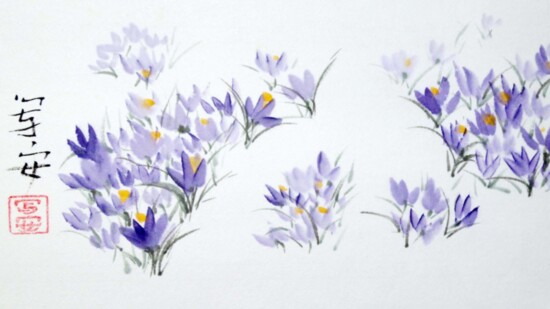Japanese ink brush painting – sumi-é – is the ultimate minimalist art form. It is one part zen meditation and one part controlled precision. In just a few strokes of a paintbrush, the artist shares a lifetime of stories.
“People often ask me how long it takes to create a painting,” recalls Shawn Wilson, an internationally-recognized sumi-é artist. “I say: 10 minutes and 30 years! In sumi-é, it isn’t just about the painting you are working on. Everything you have done has led to this moment.”
The beauty of sumi-é lies in its simplicity: the canvas left untouched, the thoughts left unsaid, moments of silence pregnant with emotion. There are no sketches for the artist to fall back on. Nothing to cover up tiny imperfections. It is raw and real, what Wilson describes as “6 impeccable strokes” on a thin piece of rice paper.
Sumi-é takes a lifetime to master. Students of the ancient art form spend years gaining control of the brush, perfecting a simple stroke, and overcoming the unforgiving nature of rice paper, which Wilson says is “like painting on toilet paper.”
A sumi-é artist also has very little medium to work with. Many paintings are even done in shades of black though Wilson confesses she enjoys adding some color. Still, “it’s an art form that doesn’t do handstands for you,” explains Wilson. “It is about tiny nuances.”
Learning to embrace those tiny nuances has given Wilson a youthful optimism. “When you identify as an artist, you see things differently. Even when I see the leafless shapes of trees in the winter, I am overwhelmed by how stunningly gorgeous they are.”
When Wilson began lessons with Sumi-é Master Koho Yamamoto in her early twenties, she was already an established artist, selling pen-and-ink drawings to New Yorker Magazine. While her artistic journey has led her around the world and through various mediums before returning to her hometown of Tulsa, it is sumi-é and her decades-long friendship with Yamamoto that have grounded her.
After 50 years as an artist, Wilson says she still feels the spark of the meditative experience: “You have to study the item you want to paint, get to know it. Consider where it came from and where it is going. Become the item. Then, paint like lightning!”
One of Wilson’s personal favorites, Crocuses is currently available for purchase at Joseph Gierek Fine Art. In this piece, flowers of deep purple and light lavender emerge in a field, newly opening in early spring. Though the painting appears to contain hundreds of meticulous strokes, it does not, in fact, contain many at all, for sumi-é requires the artist to apply various hues to the paintbrush at one time and to use meticulous control of the brush to create the illusion of many strokes.
Anticipation, a piece Wilson recently sold, displays a moment shared between two indigo birds. As one delicately perches on a tree branch, he seems to hold his breath in anticipation as a second comes in for a landing. It isn’t easy to paint movement, but Wilson has captured it so clearly that one can almost see the scene unfolding in this still image. True to sumi-é style, a few brushstrokes evoke an almost visceral response in the combination of longing and dread captured in the seconds before the birds are reunited.
These and other pieces by Shawn Wilson can be viewed at Joseph Gierek Fine Art (1342 E 11th St) or online at gierek.com/artists/shawn-wilson.






